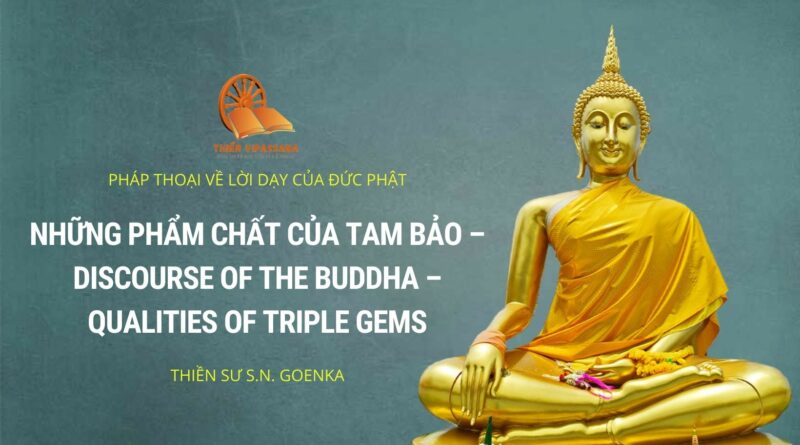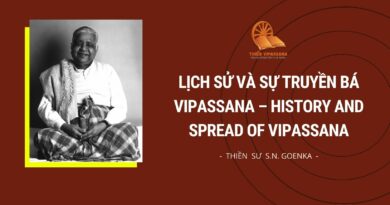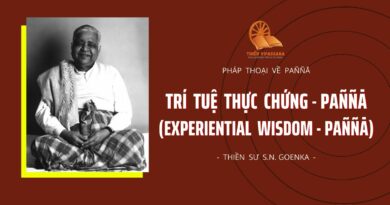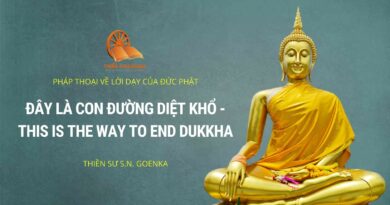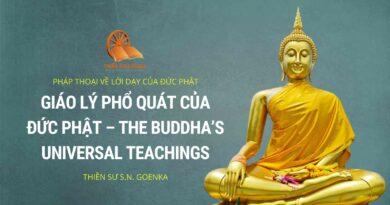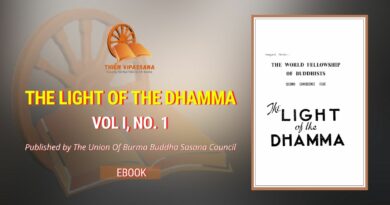Discourse of the Buddha – Qualities of triple gems – Bài giảng về Đức Phật – Những phẩm chất của Tam Bảo
By Mr. S.N.Goenka – Bởi Ngài S.N. Goenka
Followers of the Buddha take refuge in the Triple Gem: the Buddha, Dhamma and Sangha. How did the Buddha himself define these three? Gotama Buddha once defined a Buddha as follows: “A Buddha is one who, having discriminatory knowledge of the entire field of suffering, understands the arising and passing of all miseries, is completely free from mental defilements, is pristinely pure and will not be reborn.”
Những người nương theo Đức Phật quy y Tam Bảo: Phật Bảo, Pháp Bảo và Tăng Bảo. Đức Phật đã định nghĩa ba điều này như thế nào? Đức Phật Gotama đã từng định nghĩa một vị Phật như sau: “Đức Phật là một người phân biệt được toàn bộ sự đau khổ, hiểu được sự sinh ra và diệt đi của mọi khổ đau; là người hoàn toàn thoát khỏi phiền não, hoàn toàn thánh thiện và không thể tái sinh . “
A Buddha is always known by the following qualities: He is an exalted one (bhagava) because, having vanquished all craving, aversion and delusion, he lives the life of a liberated person. He is a conqueror of enemies (araham) because he has annihilated all his enemies, in the form of mental impurities. Having become fully enlightened by his own rightful efforts (samma sambuddho), he is a perfectly enlightened being. He is perfect in both wisdom and conduct (vijja-carana-sampanno). He has gone to the ultimate truth (sugato) because he has become pure in body, speech and mind. He is the knower of worlds (loka-vidu) because he understands them through personal experience. He is the unsurpassed charioteer of tameable men (anuttaro purisa-damma-sarathi) He is teacher of gods and men (sattha deva-manussanam). Anyone who acquires these qualities will become a Buddha. And whoever is a Buddha will have these qualities.
Một vị Phật luôn được biết đến bởi những phẩm chất sau: Ngài là một người xuất chúng (bhagava) bởi vì, Ngài đã vượt qua tất cả tham ái, ác cảm và si mê, Ngài sống cuộc sống của một người được giải thoát. Ngài là kẻ chinh phục kẻ thù (araham) vì Ngài đã tiêu diệt tất cả kẻ thù của mình, dưới dạng tạp chất. Sau khi được giác ngộ hoàn toàn bởi những nỗ lực chính đáng của mình (samma sambuddho), Ngài là một đấng giác ngộ hoàn hảo. Ngài hoàn hảo cả về trí tuệ lẫn đạo đức (vijja-carana-sampanno). Ngài đã đi đến sự thật tối thượng (sugato) bởi vì Ngài đã trở nên thuần khiết trong thân, khẩu và tâm. Ngài là người biết thế giới (loka-vidu) bởi vì Ngài hiểu chúng thông qua kinh nghiệm cá nhân. Ngài là người đánh xe ngựa vượt trội trong số những người đàn ông thuần hóa (anuttaro purisa-damma-sarathi. Ngài là thầy của các vị thần và con người (sattha deva-manussanam). Bất cứ ai có được những phẩm chất này sẽ trở thành một vị Phật. Và bất cứ ai là một vị Phật sẽ có những phẩm chất này.
Buddha is not the name of a person, community, or sect. There are many other appellations of Buddha, expressing his qualities, such as: Lord (bhagava), conqueror (jina), valorous (mahavira), omniscient (sabbannu), truth-discoverer (tathagata), possessor of ten strengths (dasa-bala), one having exhausted all defilements (khinasavo), highly compassionate (maha-karuniko), free from passion (vita-rago), free from aversion (vita-doso), free from delusion (vita-moho), free from craving (vita-tanho), truth-perceiver (sacca-dassi), nibbana-perceiver (nibbana-dassi), Dhamma-bodied (Dhamma-kayo), and many more. All these names signify qualities, characteristics—the nature of Buddha. They are, therefore, universal. There is nothing sectarian about these terms. Such a person teaches Dhamma as follows: This is sila, this is samadhi, this is panna. After sila is perfected, samadhi proves highly beneficial. After samadhi is perfected, panna proves highly beneficial. After panna is perfected, the mind becomes free from all impurities.
Đức Phật không phải là tên của một người, cộng đồng hay giáo phái. Có rất nhiều tên gọi khác của Đức Phật, thể hiện những phẩm chất của ông, như: Đức Thế Tôn (bhagava), người chinh phục (jina), dũng sĩ (mahavira), chúng sinh duy nhất (sabbannu), người khám phá sự thật (tathagata), người sở hữu mười sức mạnh (dathagata) ), một người đã hết tất cả phiền não (khinasavo), từ bi cao độ (maha-karuniko), thoát khỏi đam mê (vita-rago), thoát khỏi ác cảm (vita-doso), thoát khỏi ảo tưởng (vita-moho), không tham ái vita-tanho), nhận thức chân lý (sacca-dassi), nibbana-nhận thức (nibbana-dassi), Dhamma-bodied (Dhamma-kayo), và nhiều hơn nữa. Tất cả những cái tên này biểu thị cho phẩm chất, đặc điểm của bản chất Phật. Họ, do đó, phổ quát. Không có gì bè phái về các điều khoản này. Một người như vậy dạy Phật pháp như sau: Đây là sila, đây là samadhi, đây là panna. Sau khi sila được hoàn thiện, samadhi chứng tỏ lợi ích cao. Sau khi samadhi được hoàn thiện, panna chứng tỏ lợi ích cao. Sau khi panna được hoàn thiện, tâm trí trở nên thoát khỏi mọi tạp chất.
Dhamma taught by a Buddha has the following attributes:
It is well-explained (svakkhato).
It can be experienced in this life (sanditthiko).
It gives immediate results (akaliko).
It invites people to come and see (ehi-passiko).
Every successive step takes one towards the final goal of full liberation (opanayiko).
It is to be experienced by each person of average intelligence, for oneself (paccattam veditabbo vinnuhiti).
Giáo pháp do một vị Phật dạy có các tính chất sau:
- Được giải thích rõ ràng (svakkhato).
- Có thể được trải nghiệm trong cuộc sống này (sanditthiko).
- Cho kết quả ngay lập tức (akaliko).
- Thu hút mọi người đến và xem (ehi-passiko).
- Mỗi bước tiếp theo sẽ đưa người ta tới mục tiêu cuối cùng là giải thoát hoàn toàn (opanayiko).
- Nó được trải nghiệm bởi mỗi người có trí tuệ trung bình, cho chính mình (paccattam veditabbo vinnuhiti).
Dhamma is not sectarian. It is called by several other names: Eternal dhamma (esa dhammo sanantano); noble eightfold path (ariyo atthangiko maggo); true dhamma (saddhammo); pure dhamma (visuddhi-dhammo); dhamma leading to full liberation (vimutti-dhammo); noble dhamma (ariyo-dhammo); stainless dhamma (sukka dhammo); foremost dhamma (aggo dhammo); ancient dhamma (purano dhammo).
Dhamma (Pháp Bảo) không phải là giáo phái. Nó được gọi bằng một số tên khác: Eternal dhamma (esa dhammo sanantano); con đường cao quý có tám phần (ariyo atthangiko maggo); Dhamma thực sự (saddhammo); Dhamma thánh thiện (visuddhi-dhammo); Dhamma dẫn đến giải thoát hoàn toàn (vimutti-dhammo); Dhamma cao quý (ariyo-dhammo); Dhamma tinh khiết (sukka dhammo); Dhamma đầu tiên (aggo dhammo); Dhamma cổ xưa (purano dhammo).
The Sangha characterized by the Buddha comprises those who, practicing Dhamma according to his teachings, have become stream-enterer, once-returner, non-returner or fully enlightened ones. This is not an assembly of ordinary people. Like Buddha and Dhamma, Sangha is characterized by universal qualities such as: Being worthy of invitation (ahuneyyo); worthy of hospitality (pahuneyyo); worthy of offerings (dakkhineyyo); worthy to be saluted with folded hands (anjali-karaniyo); field of merit par excellence (anuttaram punna-kkhettam); temperate, tranquil (danto, santo); free from passion, spotless (virajo, vimalo); composed, not diffused (nippapanco). When we take refuge in the Triple Gem, when we honour Buddha, Dhamma and Sangha, let us remember their qualities, and work diligently to develop these very qualities ourselves.
Tăng Bảo được phân loại bởi Đức Phật bao gồm những người thực hành Dhamma theo giáo lý của Ngài, đã trở thành người nhập tâm, người trở về một lần, người không trở về hoặc người giác ngộ hoàn toàn. Đây không phải là một tổ chức những cá nhân bình thường. Giống như Phật và Pháp, Tăng thân được đặc trưng bởi những phẩm chất phổ quát như: Được xứng đáng được mời (ahuneyyo); xứng đáng với lòng hiếu khách (pahuneyyo); xứng đáng cúng dường (dakkhineyyo); xứng đáng được chào đón với bàn tay chắp lại (anjali-karaniyo); công đức xuất sắc (anuttaram trừngna-kkhettam); ôn hòa, yên tĩnh (danto, santo); thoát khỏi đam mê, không tì vết (virajo, vimalo); sáng tác, không khuếch tán (nippapanco). Khi chúng ta quy y Tam Bảo, khi chúng ta tôn kính Phật, Pháp và Tăng, chúng ta hãy ghi nhớ những phẩm chất của họ, và làm việc siêng năng để tự phát triển những phẩm chất này.

